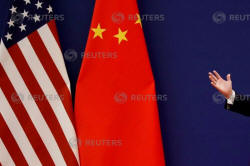Home modems, routers hit by U.S. China tariffs as
'smart' tech goods escape
 Send a link to a friend
Send a link to a friend
 [September 24, 2018]
By David Lawder [September 24, 2018]
By David Lawder
WASHINGTON (Reuters) - U.S. tariffs that
hit some $200 billion worth of Chinese products on Monday spare many
high-profile consumer technology items such as "smart" watches and
speakers, but the less flashy home modems, routers and internet gateways
that make them work weren't so lucky.
Consumer tech industry officials and the U.S. Customs and Border
Protection agency say they expect billions of dollars worth of these
products, including those designed for home use, will be subject to the
10 percent tariffs activated on Monday.
The move will effectively create a two-tiered tariff structure for
consumer internet, with many products, such as Fitbit <FIT.N> fitness
trackers, Apple Inc's <AAPL.O> watch and Amazon.com Inc's <AMZN.O> Echo
smart speaker being favored over routers and internet gateways from
Arris International <ARRS.O>, Netgear <NTGR.O>, D-Link <2332.TW> and
others.
"We're operating under the assumption that the tens of millions of
devices that deliver high-speed internet into consumers' homes will be
impacted by these tariffs," said Jim Brennan, Arris' senior vice
president of supply chain, quality and operations.

"It feels anti-consumer because our devices are what enables the core of
consumer tech," Brennan told Reuters.
The modems, routers, switching and networking gear that keep the
internet functioning were not included in a newly created U.S. tariff
code that was exempted from the latest China tariffs, a spokesperson for
the U.S. Customs and Border Protection agency said.
The agency has made no distinction between consumer-use modems and
routers and the commercial network equipment used by data centers and
broadband internet providers.
Most new internet-connected devices had been lumped into a broad
category in the U.S. Harmonized Tariff Schedule, 85176200, "Machines for
the reception, conversion and transmission or regeneration of voice,
images or other data, including switching and routing apparatus."
The catch-all category saw $23 billion in U.S. imports from China and
$47.6 billion from the world last year. It was the largest component of
U.S. President Donald Trump's latest tariffs targeting Chinese goods.
The U.S. Trade Representative's office had said it was breaking out
items such as smart watches, fitness trackers, Bluetooth audio streaming
devices and smart speakers into a new subcategory that would be
exempted, but it gave few details.
[to top of second column] |

U.S. President Donald Trump delivers his speech next to U.S. and
Chinese flags as he and Chinese President Xi Jinping meet business
leaders at the Great Hall of the People in Beijing, China, November
9, 2017. REUTERS/Damir Sagolj/File Photo

According to a notice posted by the U.S. International Trade Commission,
computer modems would stay in a separate sub-category, while "switching and
routing apparatus" would be put into a new sub-category. Neither of these
sub-categories were granted exemptions from the tariffs.
"Although we have not had occasion to issue rulings on the scope of a provision
for 'switching and routing apparatus,' we agree that as a general matter,
modems, routers, and networking equipment will be subject to the remedy," a
Customs and Border Protection spokesperson said late on Friday, referring to the
10 percent tariff.
It was not clear how much of the $23 billion in Chinese imports within the
catch-all category could escape tariffs, but a Reuters review of industry data
suggests the share could be small.
U.S. Census Bureau data has not yet captured the volume of annual imports from
China — or any country — of the goods that will be exempt.
But the Consumer Technology Association estimates that the U.S. market for
fitness trackers, smart watches, smart speakers and wireless earbuds and
headphones was $8.2 billion in 2017, with forecast sales of $11.6 billion for
2019.
Even if China produced a majority of those goods, exemptions would only apply to
a fraction of the $23 billion category.
CTA has forecast direct sales of modems and routers to consumers at $2.3 billion
for 2019, up from $2 billion in 2017, excluding the products supplied directly
by cable and broadband internet providers and equipment used in data centers and
other infrastructure outside the home.
But the group argues that consumers will bear the costs of the tariffs, even if
their service provider buys the modems.
"Overall, access to the internet will get more expensive, mobile plans will get
more expensive, and connected devices that go to your smart phones will get more
expensive because everything speaks to each other," said Izzy Santa, director of
strategic communications for CTA.
(Additional reporting by Jason Lange in Washington and Stephen Nellis in San
Francisco; Editing by Michael Perry)
[© 2018 Thomson Reuters. All rights
reserved.] Copyright 2018 Reuters. All rights reserved. This material may not be published,
broadcast, rewritten or redistributed.
Thompson Reuters is solely responsible for this content. |